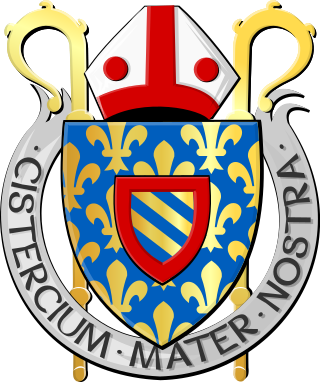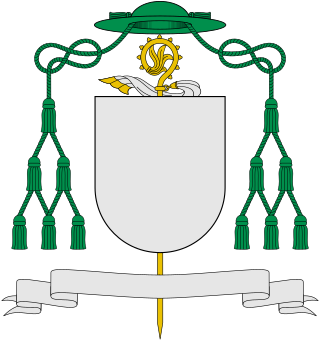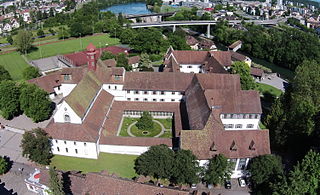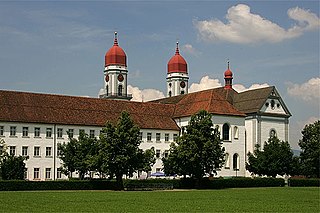
The Benedictines, officially the Order of Saint Benedict, are a mainly contemplative monastic religious order of the Catholic Church for men and for women who follow the Rule of Saint Benedict. The male religious are also sometimes called the Black Monks, in reference to the colour of their religious habits, in contrast to other Benedictine orders such as the Olivetans, who wear white. They were founded in 529 by Benedict of Nursia, a 6th-century Italian monk who laid the foundations of Benedictine monasticism through the formulation of his Rule. Benedict's sister, Scholastica, possibly his twin, also became a religious from an early age, but chose to live as a hermit. They retained a close relationship until her death.

The Cistercians, officially the Order of Cistercians, are a Catholic religious order of monks and nuns that branched off from the Benedictines and follow the Rule of Saint Benedict, as well as the contributions of the highly-influential Bernard of Clairvaux, known as the Latin Rule. They are also known as Bernardines, after Saint Bernard himself, or as White Monks, in reference to the colour of the "cuculla" or cowl worn by the Cistercians over their habits, as opposed to the black cowl worn by Benedictines.

The Trappists, officially known as the Order of Cistercians of the Strict Observance and originally named the Order of Reformed Cistercians of Our Lady of La Trappe, are a Catholic religious order of cloistered monastics that branched off from the Cistercians. They follow the Rule of Saint Benedict and have communities of both monks and nuns that are known as Trappists and Trappistines, respectively. They are named after La Trappe Abbey, the monastery from which the movement and religious order originated. The movement first began with the reforms that Abbot Armand Jean le Bouthillier de Rancé introduced in 1664, later leading to the creation of Trappist congregations, and eventually the formal constitution as a separate religious order in 1892.

Lérins Abbey is a Cistercian monastery on the island of Saint-Honorat, one of the Lérins Islands, on the French Riviera, with an active monastic community.

Petershausen Abbey was a Benedictine imperial abbey at Petershausen, now a district of Konstanz in Baden-Württemberg, Germany.

Göttweig Abbey is a Benedictine monastery near Krems in Lower Austria. It was founded in 1083 by Altmann, Bishop of Passau.

A territorial abbey is a particular church of the Catholic Church comprising defined territory which is not part of a diocese but surrounds an abbey or monastery whose abbot or superior functions as ordinary for all Catholics and parishes in the territory. Such an abbot is called a territorial abbot or abbot nullius diœceseos. A territorial abbot thus differs from an ordinary abbot, who exercises authority only within the monastery's walls or to monks or canons who have taken their vows there. A territorial abbot is equivalent to a diocesan bishop in Catholic canon law.

Casamari Abbey is a Cistercian abbey in the Province of Frosinone, Lazio, Italy, about 10 kilometers east-south-east of Veroli.

Father Alberich or Alberik Zwyssig was a Cistercian monk who composed in 1841 the Swiss Psalm, the present Swiss national anthem.

Wettingen Abbey was a Cistercian monastery in Wettingen in the Swiss canton of Aargau. It was founded in 1227 and dissolved during the secularisation of 1841, but re-founded at Mehrerau in Austria in 1854. The buildings are listed as a heritage site of national significance.

Hauterive Abbey is a Cistercian abbey in the Swiss municipality of Hauterive in the canton of Fribourg. It is a Swiss heritage site of national significance. The entire Hauterive area is part of the Inventory of Swiss Heritage Sites.

St. Urban's Abbey is a former Cistercian monastery in the municipality of Pfaffnau in the canton of Lucerne in Switzerland. It is a Swiss heritage site of national significance.
The Abbey of Our Lady of Spring Bank, founded in 1928, was an American monastery of monks of the Cistercian Order of the Ancient, or Common, Observance in Wisconsin. These form a separate branch of the Order from the Cistercian monks of the Strict Observance, most commonly known as Trappists. This abbey was the first monastery of the Order to be established in the United States. The community was closed in 2011.

Anselm van der Linde O.Cist. is a Cistercian abbot of the common observance, an Austrian citizen born in South Africa. He was Abbot of the Territorial Abbey of Wettingen-Mehrerau from 2009 to 2018.
Bertha of Rheinfelden, countess of Kellmünz, was the daughter of Rudolf of Rheinfelden and wife of Ulrich X of Bregenz.
Ulrich X was Count of Bregenz from 1079 to his death in 1097.
In some religious orders of the Catholic Church, a congregation is a group of religious houses. In monastic orders, this would be monasteries; in orders of canons regular, this would be chapters. Each congregation operates as an autonomous or independent subdivision of the religious order, and is presided over by a superior with a title such as abbot general, arch-abbot, abbot president, president, abbot ordinary, provost general or superior general.

Kassian (Otto) Lauterer was an Austrian Roman Catholic priest.






















